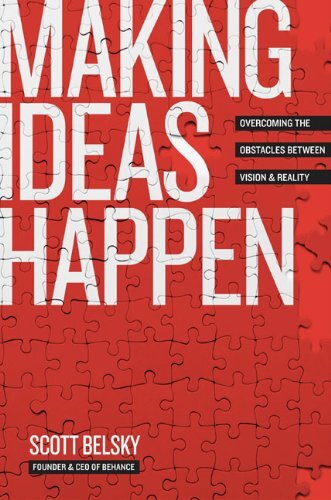Scott Belsky, Making Ideas Happen: Overcoming the Obstacles Between Vision and Reality. Portfolio Hardcover, 2010.
Referenced in: Change Concepts and Theories
LifeandLeadership.com Summary
This Wall Street Journal bestseller is a helpful tool for the actual execution of visionary ideas, whether in churches or anywhere else. It distills 6 years of research on how creative individuals and teams translate their dreams into reality. The research looks at the methods of organizations like Google, IDEO, and Disney, and other individuals who succeed at bringing ideas to fruition. It provides a systematic, step-by-step, repeatable process. Foundational to this process are three overarching commitments: Getting Organized, Collaborating, and Leading.
The first, Getting Organized, spells out Belsky’s “Action Method” of three components:
- Action Steps – Break each stage into a succession of separate projects that are necessary to move the idea forward. Contrary to popular lore, the process of making things happen is actually quite linear.
- References – Keep a log of information that is important but not necessarily actionable, References
- Backburners – Have places to store ideas for future consideration.
The second, Collaboration, involves assembling a creative team. Teams accomplish more than individuals. Team members offer needed critique, and balance the creative tensions such as dreamer vs. doer. Ideas start with dreamers, who tend to avoid the more practical doers. When the two synergize, however, more is accomplished.
The third, Leadership, is taking responsiblity for seeing it through. It involve leading self, leading the team to believe in their importance relative to the projects, continually feeding passion for the big idea as it is being executed.
From the Publisher
Edison famously said that genius is 1 percent inspiration, 99 percent perspiration. Ideas for new businesses, solutions to the world’s problems, and artistic breakthroughs are common, but great execution is rare.
According to Scott Belsky, the capacity to make ideas happen can be strengthened by anyone willing to build their organizational habits and harness the forces of community. That’s why he founded Behance, a company that helps creative people and teams across industries develop these skills.
Belsky has spent six years studying the habits of especially productive creative people and teams-the ones who make their ideas happen time and time again. After interviewing hundreds of successful creatives, he has compiled their most powerful-and often counterintuitive-practices, such as:
- Generate ideas in moderation and act without conviction
- Reduce all projects to just three primary components
- Encourage fighting within your team
- Seek competition and share ideas liberally
In an increasingly flexible and entrepreneurial environment, creative minds have the opportunity (and responsibility) to solve and change industries-but they can only do that if they overcome the obstacles. While many of us obsess about discovering great new ideas, Belsky shows why it’s better to develop the capacity to make ideas happen-a capacity that endures over time.
About the Author
Scott Belsky is the founder and CEO of Behance, which operates the leading online platform for creative professionals, as well as the 99% Conference, a major annual symposium on execution in creative industries. Previously he helped grow the Pine Street Leadership Development Initiative at Goldman Sachs.
***For additional information on this resource, including reviews, click the bookstore links. Check the reference at page top or the links below for resource guides on related topics.***
See Resource Guides on Over 100 Areas of Ministry Leadership:


